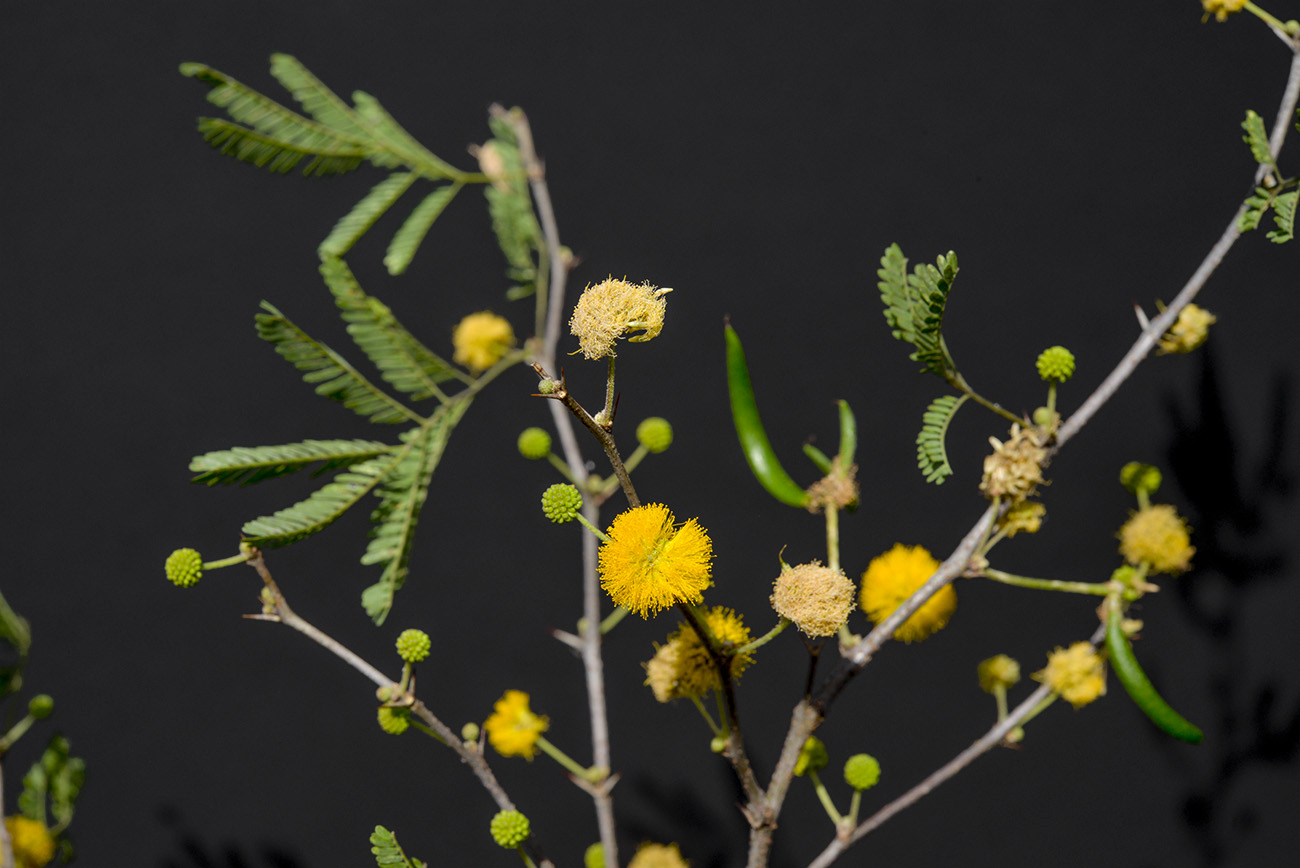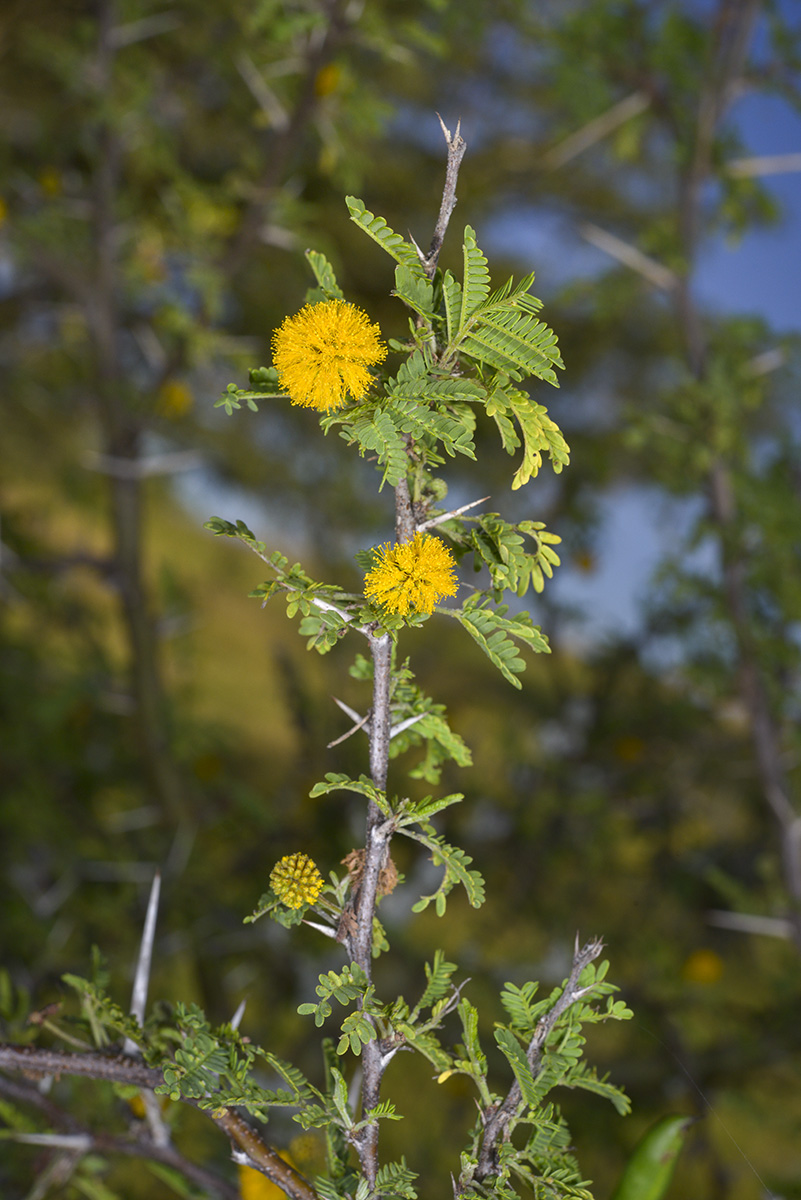Acacia farnesiana (Fabaceae) is a small tree or shrub 3 meters tall on average. Its leaves are composed of folios of 10 - 20 pairs and its stems have spines of 0.5 - 5cm. Its flowers are yellow and aromatic. It is distributed from the United States to Argentina (Hernández, 1978), in Guatemala, our FLAAR team has photographed this species in the Arroyo Petexbatún, Sayaxché, Petén and it is understandable because according to CONABIO (n.d.) the species develops along the roads, streams, abandoned parcels, disturbed lands, successional lands, and ruderal sites. In addition, it grows in hot and semi-warm climates.
Acacia farnesiana or commonly called Subín by the locals of Petén, has many potential uses as indicated by CONABIO (n.d.):
- Adhesive. Latex is used as a substitute for gum.
- Aromatic. Its essential oil is used in the perfume industry
- Wood and firewood.
- Dye. The flowers and fruits contain pigments that are used to dye silk fabrics and wallpaper. The powdered and boiled pod produces a black liquid that can be used as ink.
- Flavor. The leaves are used to flavor
- Tanning. Its bark and pods are used to tan and dye leather due to its abundance of tannins.
- Forage. The leaves, pods, flowers and stems are used as fodder for cattle and goats.
- Insecticide. The roots have a strong odor and are used as an antidote to poisons. The powder from the seeds is smeared on the horses' hooves to rid them of parasites. The leaf extract is used for protection against bean rust.
- Medicinal. The decoction of the flowers is used as a remedy in cases of dyspepsia. An ointment is made from the flowers that is used as a remedy for headaches. With the green fruit, which is very astringent, an infusion is prepared for inflammations of the skin and mucous membranes (fires, hemorrhages) and to calm disorders of the nervous system. The root decoction is useful for dysentery, tuberculosis and abdominal pain. The stem is used for jaundice, toothache. The dried and powdered leaves are applied as a bandage on wounds.
- Melliferous. Beekeeping
- Ceremonial. In Tabasco it is used to drive away evil spirits.
Acasia Farnesiana found at Quiche, Nov 1, 2013 Photograph by Dr Nicholas Hellmuth.
PDF, Articles, Books on Acacia farnesiana
- 2013
- Historia Natural del Parque Nacional Cumbres de Monterrey, México. Universidad Autónoma de Nuevo León. Primera Edición, 414 pages.
Useful information about uses in page 318
Available Online:
https://www.researchgate.net/profile/Magdalena_Salinas-R/publication/
277555835_Angiospermas/links/556c7a3808aeab777223143c.pdf#page=284
- n.d.
- Acacia farnesiana. Ficha informativa.
The document mentions the uses of the plant.
Available Online:
www.conabio.gob.mx/conocimiento/info_especies/arboles/doctos/38-legum4m.p
- 2013
- Efecto de la temperatura en la germinación de Acacia farnesiana y A. schaffneri de diversas procedencias, y variación en vainas y semillas. Universidad Autónoma de Nuevo León. 60 pages.
- n.d.
- Acacia farnesiana (L.) Willd. International Institute of Tropical Forestry, USDA Forest Service. Part II. Pages 247-249.
Available Online:
https://rngr.net/publications/ttsm/species/Acacia%
20farnesiana.pdf/at_download/file
- 1978
- Uso potencial de Acacia farnesiana y Posibles Repercusiones Ecológicas. Tesis profesional. Universidad de Guadalajara, Escuela de Agricultura. 39 pages.
Available Online:
http://repositorio.cucba.udg.mx:8080/xmlui/bitstream/handle/123456789/2155/
Hernandez_Rivera_Armando.pdf?sequence=1
- 2010
- Uso potencial del huizache (Acacia farnesiana L. Will) en la fitorremediación de suelos contaminados con plomo. Revista Chapingo Serie Ciencias Forestales y del Ambiente. Vol. XVII. Pages 11-20.
Available Online:
www.researchgate.net/publication/237038046_
POTENTIAL_USE_OF_HUIZACHE_Acacia_
farnesiana_L_Will_IN_PHYTOREMEDIATION
_OF_LEAD-CONTAMINATED_SOILS_USO_
POTENCIAL_DEL_HUIZACHE_Acacia_farnesiana
_L_Will_EN_LA_FITORREMEDIACION_DE_
SUELOS_CONTAMINADOS_CON_
- 2008
- Generic and subgeneric names in Acacia following retypification of the genus. Muelleria. Vol. 26, No. 1. Pages 7-9.
Available Online:
www.rbg.vic.gov.au/documents/Muelleria_26(1),_p7-9,_Maslin,_Generic_and_subgeneric.pdf
- 2014
- Desarrollo de plántulas de huizache (Aacia farnesiana) en sustratos con vermicompost. Rev. Chapingo. Ser. Cienc. For. Ambient. Vol. 20, No. 1. Pages 55-62.
Available Online:
www.scielo.org.mx/pdf/rcscfa/v20n1/v20n1a6.pdf
- 2014
- Árboles de Centroamérica. Acacia farnesiana (L.) Wild. Pages 323-326.
Available Online:
www.arbolesdecentroamerica.info/index.php/es/species/item/download/
36_3720a1b4e649009f0f52c2925f2ff7a4
- 2005
- The case for conserving Acacia with a new type. Taxon. Vol. 54, No. 2. Pages 509-512.
Available Online:
www.iapt-taxon.org/historic/Congress/IBC_2011/Acacia_for.pdf
- 2001
- El género Acacia (Leguminosae, Mimosoideae) en el Estado de Oaxaca, México. Anales del Jardín Botánico de Madrid. Vol. 58, No. 2. Pages 251-302.
Available Online:
www.rjb.csic.es/jardinbotanico/ficheros/documentos/
pdf/anales/2000/Anales_58(2)_251_302.pdf
- 2011
- Árboles del Valle Central de Costa Rica: reproducción. Revista Forestal Mesoamericana Kurú (Costa Rica). Vol. 9, No. 22. Pages 66-67.
Available Online:
https://dialnet.unirioja.es/descarga/articulo/5123340.pdf
- 2005
- New combinations in the genus Vachellia (Fabaceae: Mimosoideae) from the new world. Phytologia. Vol. 87, No. 3.
Available Online:
www.biodiversitylibrary.org/item/46895#page/3/mode/1up
- n.d.
- Acacia farnesiana. Ficha informativa.
Free Online:
www.conabio.gob.mx/conocimiento/info_especies/arboles/doctos/38-legum4m.pdf
Suggested webpages with photos and information on Acacia farnesiana
www.theplantlist.org/tpl/record/ild-423
Synonyms.
https://hablemosdeflores.com/la-acacia-farnesiana/
Useful information and photos
www.crbio.cr:8080/neoportal-web/species/Acacia%20farnesiana
Uses and management
www.conabio.gob.mx/conocimiento/info_especies/arboles/doctos/38-legum4m.pdf
Information.
www.conabio.gob.mx/malezasdemexico/mimosaceae/acacia-farnesiana/fichas/pagina1.htm
Photos and information.
Updated February
First posted March, 2018
Bibliography prepared by Marcella Sarti and updated by Vivian Hurtado, FLAAR Mesoamerica.















































































